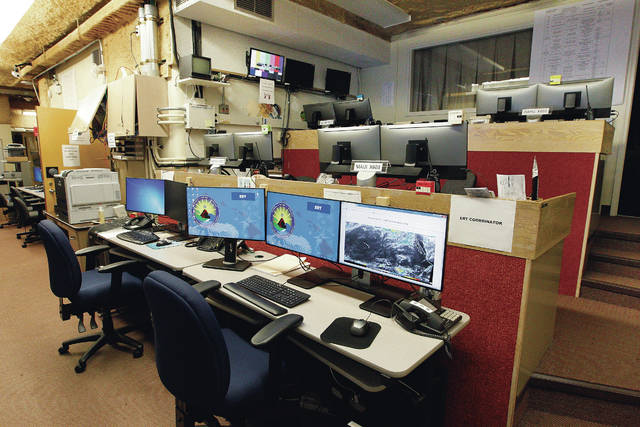The state “warning officer” at the center of Saturday’s bogus alert of an imminent missile attack that triggered widespread panic is a 10-year veteran and nonunion, exempt employee who has received “dozens of death threats by fax, telephone, social media,” the executive officer of the Hawaii Emergency Management Agency told the Honolulu Star-Advertiser on Monday.
Toby Clairmont, the agency’s executive officer, said Honolulu police are investigating the death threats against the unnamed employee and his family. He’s one of 10 warning officers entrusted with alerting island residents and visitors of both natural and man-made threats against Hawaii.
“This person is distraught that they’ve received death threats,” Clairmont said. “This is hard. What can be worse than this? Running over a child in a crosswalk and you realize you did it? It’s that kind of feeling. … This employee is not doing well. We need to help them, too.”
Warning officers continued to work in a room inside the agency’s Diamond Head headquarters Monday called the “state warning point” where Saturday’s bogus alert originated, according to Richard Rapoza, the agency’s spokesman.
But as of Monday the room is now off-limits because of the ongoing investigations about what happened Saturday, Rapoza told the Star-Advertiser from the much larger “dais” room down the hall from the “state warning point.”
Many questions remain unanswered about what happened Saturday, Rapoza said, including reports about why outdoors sirens went off on military bases but apparently not in civilian areas.
“We didn’t trigger any sirens,” Rapoza said. “That’s something that will have to be investigated.”
Some television viewers Saturday morning also saw a red alert message crawl across the top of their television screens from something called “IPAWSCAP,” which stands for “Integrated Public Alert and Warning System” and referenced the U.S. Pacific Command, Rapoza said.
The television crawl is pre-written and is supposed to kick in only during a real attack, Rapoza said.
“If there’s an actual attack, we receive word of that from Pacific Command,” Rapoza said. “So if Pacific Command detects a launch, it notifies us via secure phone. That is the preprogrammed message. It’s part of the modernization and integration of the nation’s alert and warning infrastructure.”
Inside the “state warning point,” two warning officers are on duty 24/7, said Clairmont, who is leading the agency’s internal investigation of Saturday’s mishap, one of several investigations that are already underway or scheduled to be launched.
‘Just dumbstruck’
The employee who triggered the false alert has since been reassigned to an unspecified job “within the operations branch” so he “can’t possibly get near the process again,” Clairmont said. “He’s been reassigned to other operations duties that do not involve those of a warning officer.”
Clairmont said he understands the public outcry to punish the employee.
“Somebody called me on the phone and said, ‘Toby, you’ve got to shoot someone,’” Clairmont said. “This person is distraught that they’ve received death threats.”
The employee has not been disciplined and is cooperating with an ongoing investigation that is scheduled to result in a report to Gov. David Ige and the state Legislature on what happened by Friday morning, Clairmont said.
“If we were to do something arbitrary like terminate him, we would lose his input into the process,” Clairmont. “We want … the truth of what happened.”
But the employee does face possible disciplinary action.
“Anything from a reprimand to termination is on the table,” Clairmont said. “He’s an exempt, nonunion labor employee.”
All 10 warning officers are nonunion employees, Clairmont said.
On Saturday morning four people were on duty, including a supervisor who also was coming on during a shift change, Clairmont said.
“It’s not as easy saying it was one person doing this,” Clairmont said. “It would be very unjust to put our finger on one person. … There were at least four people in the room at the time, including a supervisor and three warning officers. That’s what leads us to believe it’s not as simple as people think. Maybe something was said in the room that was misinterpreted. Maybe there were too many people in the room.”
A supervisor “has to approve the action,” Clairmont said. “You see? It’s complicated. We need to get into exactly what happened.”
But it was one warning officer, in particular, “who clicked the button,” Clairmont said. “There was one individual, a very well-trained and seasoned employee. He’s not someone we hired off the street. This was someone we could depend on. There had to be more to it.”
Clairmont called the ongoing investigation “an unprecedented review for our agency.”
“We’re just dumbstruck,” he said. “We owe it to ourselves and to the people of Hawaii to get to the bottom of what happened.”
As for the public outcry to punish the warning officer who triggered the false alarm, Clairmont said:
“When I see reports, comments, made by the public, I get it,” Clairmont said. “I would be angry, too. That may be the world we live in. But I have a stable of people to worry about to protect you from a tsunami tonight.”

